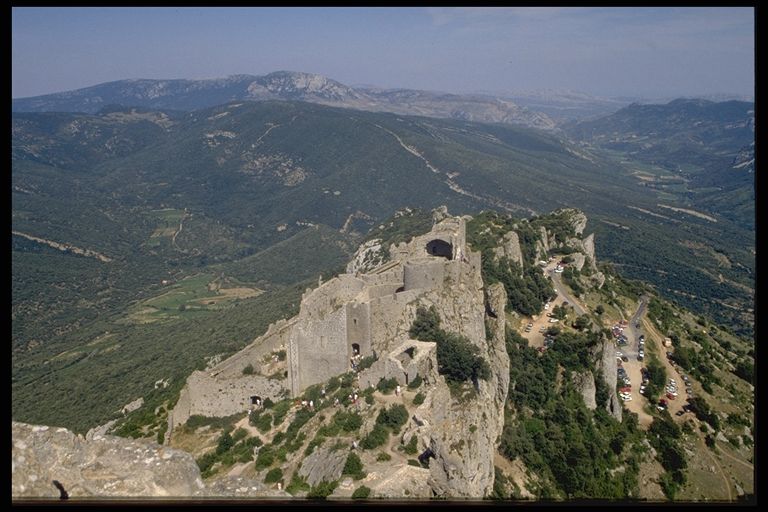
There are basicly three kinds of building covered by the term château. First, there are the medieval castles, most of which are branded as "Cathar Castles" in the Languedoc. The second are post-medieval defensive buildings designed for the age of gunpowder. They are typically squatter than ancient castles, and feature pointed bastions rather than circular or square towers. Third are the later comfortable country houses, often dressed up with cosmetic towers and machiolations - the typical Loire valley type.
In English these three types are distingushed by the names "Castle", "Fortress" and "Country House". In French they are all châteaux but the defensive ones may be distinguished as "châteaux forts".

For many centuries the Languedoc witnessed repeated invasions, bloodshed and massacre. It was for this reason that the Greeks had built hill top fortresses called opidda (one oppidum, more than one oppida).
Even when no wars were raging, bands of armed brigands would terrorise the population. In the middle ages such brigands, called "routiers", roamed the area. In this territory and with the prevaling local politics, the Counts of Toulouse and of Barcelona had little hope of eliminating this menace.
As the Greeks had build oppida, so the locals now built bastides, fortified hilltop villages, some of them "circulades". Local nobles did the best they could, and built not merely hill-top castles but mountain-top castles. These castles were wonderful defensive positions, often described as unassailable or "inexpungible". They came in handy for the next major war against the local population, or rather series of wars, which is generally known as the "Albigensian Crusade" or "Cathar Crusade".
The local nobles could have simple handed over known Cathars to the Crusaders, but they chose not to. Bound to the land and their people, speaking Occitan, imbuded with the ideals of the troubadors, champions of toleration, and often Cathar believers themselves, the nobles naturally helped and defended their Cathar families, friends, allies and vassals. Castles throughout the area became Cathar strongholds, but only in this sense. These strongholds were never "Cathar Castles", as much tourist literature would have you believe.
After the Cathar Crusades, the position was little better. Even after the the area had been annexed to France at the end of the Crusades, the local population occasionally petitioned the King of Aragon to come to their rescue. The Black Prince terrorised the area. The French and Aragonese fought over it for centuries to come, and it was ravaged again at the end of the sixteenth century when the Catholic Church tried to exterminate yet another belief system that it regarded as a "heresy" - this time Protestantism.
With this continual instability it made sense for the French kings to consolidate their hold on the area. And they did this by demolishing the old mountain top fortresses and building their own brand-new up-to-date state-of-the-art castles on the same sites. Especially important were the "Five Sons of Carcassonne", Aguilar, Queribus, Pierrepertuse, Termes and Puylaurens: five castles strategically placed to defend the French border against the Spanish.
The need to keep up these these border fortresses disappeared after the present French-Spanish border was established by the Treaty of the Pyrenees in 1659. Some of the old border castles were "slighted", deliberately damaged so that no one else could use them, and then abandoned to the elements. For the most part it is these later constructions, deliberately destroyed by their owners, that the tourist literature will advertise as "Cathar Castles".
The flip side of this - all but ignored by the tourist industry - is that, after 1659, Louis XVI commissioned a military genius to build (or repair) another set of castles to protect the new border.
